If Olios Giganteus Has Babies Indoors Will They Go Outside
Back to Insects
Arachnids:
Form Arachnida
Arachnids are a form of arthropods that comprise some large orders such as spider, ticks/mites, harvestmen, scorpions, and more. They can be distinguished from insects by having 4 pairs of legs, no antennae, a cephalothorax & abdomen, and chelicerae instead of mandibles.
Spiders:
Order Araneae
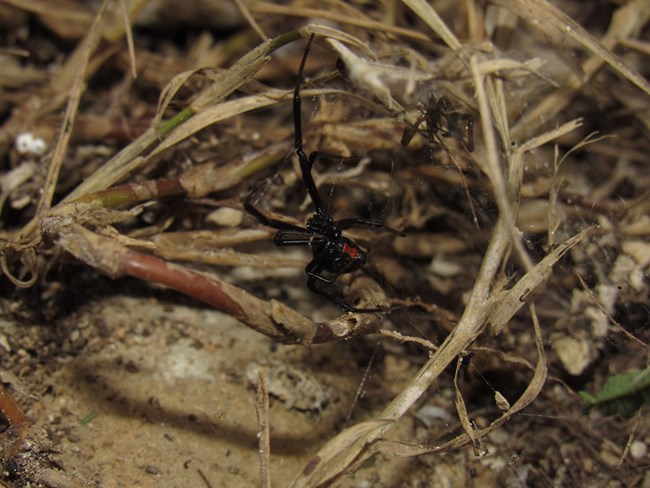
NPS photo/James C Akers
Black Widows
Latrodectus spp.
The Black Widow is a common name that refers to a few different species in the genus Latrodectus. Widow spiders are some of the most notorious spiders, by and large due to the fact that they are one of simply 2 spiders considered to have a medically pregnant seize with teeth here in the U.S. Despite this, they are timid spiders that would much sooner run away than use any of their precious venom on you. The only times bites occur are when they are existence grabbed/squeezed accidentally and feel threatened. In order to avoid this, information technology'due south best to know where to look and then yous don't disturb them! Look for this cobweb weaver building its web in shaded areas close to the ground. If you don't mess with them, they make for peachy pest control, too. The juvenile form of the Blackness Widow is a mottled, yellowish-white colour. As it matures, this spider gradually turns black until only the distinctive hourglass marker remains on the lower abdomen. Males are normally smaller than females with longer legs, and they often exhibit a distinct white and black coloration.
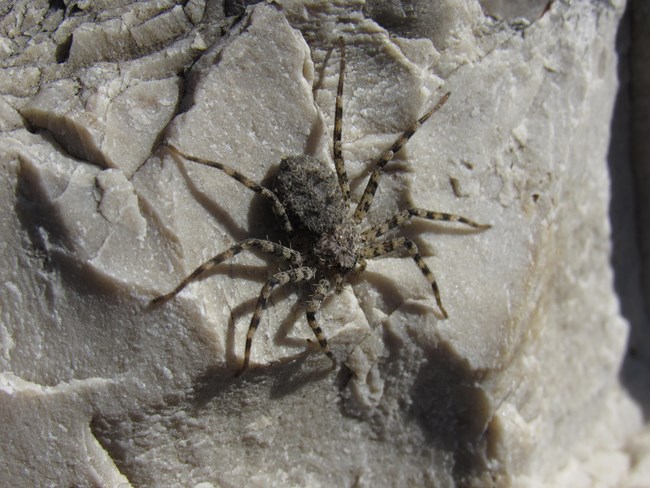
NPS Photo/James C Akers
Flatties
Selenops spp.
Spiders in the genus Selenops are often called "Flatties" for their thin and flat advent. While their common name might non exist the most creative, the etymology behind the proper name for the genus is more interesting. The name is a combination of two Greek words, "selene-" meaning moon/crescent, and "-ops" meaning centre. Some other interesting facts about these Flatties are their unique ability to glide and maneuver in the air while falling. They also accept one of the fastest turning movements of all terrestrial animals, which, when coupled with the big field of view provided by the crescent centre layout, allows them to attack prey omni-directionally. This suits their part of beingness cryptically camouflaged ambush predators.
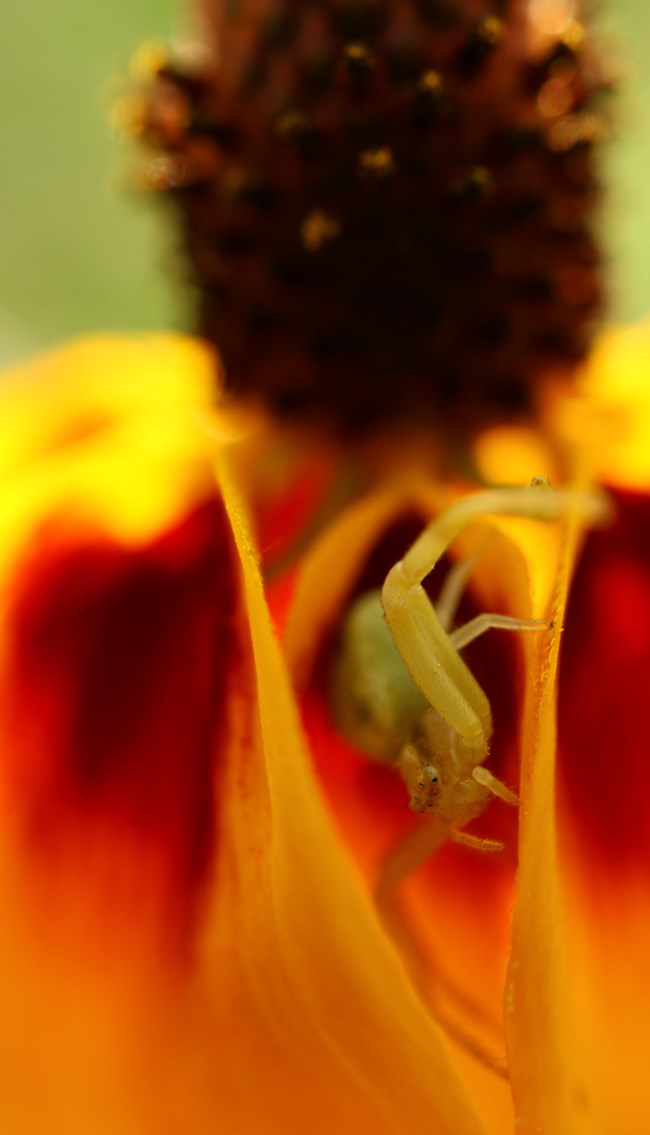
NPS Photograph/Jack Johnson
Flower Crab Spider
Misumenops celer
The coloration of the flower crab spider varies greatly, ranging from white to xanthous, or even a bright dark-green. Male flower crab spiders have ruby-red markings along the outer edge of their bodies and small bands of cerise on their 2 front legs. The front legs of the female person are lighter in color and lack the red markings. Bloom crab spiders are usually plant in cotton wool plants, and on sure cactus flowers.
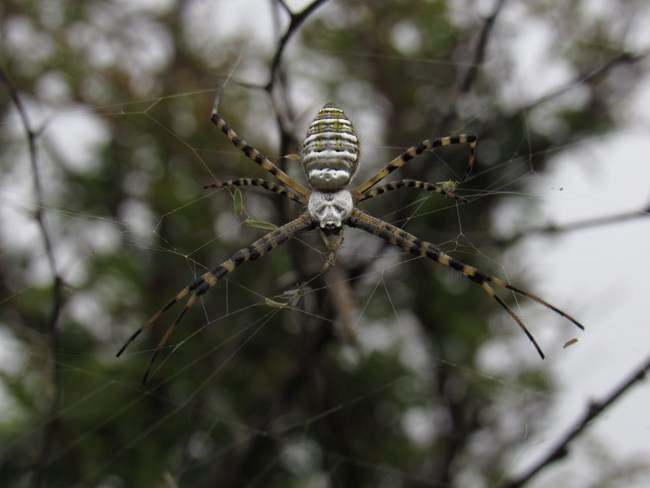
NPS Photo/James C Akers
Garden Orb Weavers
Argiope spp.
These spiders in the genus Argiope are known for weaving large orb webs, often depression plenty that you could walk through them. Luckily, their bright colors and a banded silk pattern, called a stabilimentum, helps make them more than visible to foreclose larger animals or people from accidentally destroying their webs. They oft align their legs with the pattern of the stabilimenta, often forming an "X". These brightly colored spiders are usually striped and have a silvery carapace. These are very benign spiders to have around, as they are an efficient natural pesticide service! Females tin lay between 400-1400 eggs in an egg sac.
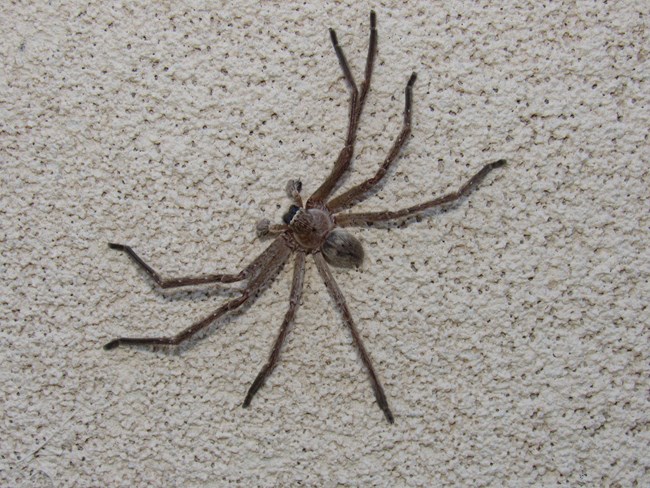
NPS Photo/Jame C Akers
Giant Crab Spider
Olios giganteus
Giant Crab spiders are another common name for Huntsman spiders in the family Sparassidae. The most iconic Giant Crab spider hither in united states of america is Olios giganteus. Similar all Huntsman spiders, O. giganteus is a speedy predator that chases down its prey. They can be identified by their darkened chelicerae, a prominent heart mark (not the standard eye shape, rather a darkened patch over their actual heart), and rotated legs (which gives them the crab shape).
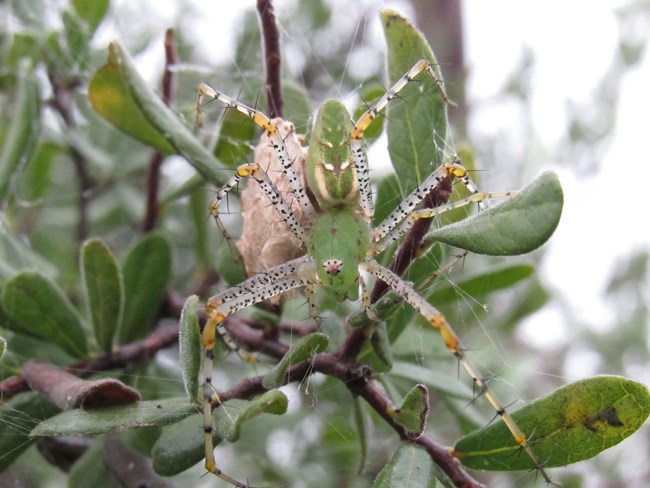
NPS Photo/James C Akers
Green Lynx Spider
Peucetia viridans
Named for the bright dark-green color of its body, the dark-green lynx spider can be plant hidden amid flower blossoms. The bright green color helps the green lynx to blend with its environment in order to stalk its small insect prey. The legs of the green lynx are more yellowish than the rest of the trunk and covered in short black spines. Spiderlings are brilliant orangish immediately after nascence. Female green lynx spiders tenaciously baby-sit their straw-colored egg sacs, oftentimes constructing protective shelters out of scattered leaves. The egg sacs of the greenish lynx tin incorporate from 150 to 600 eggs
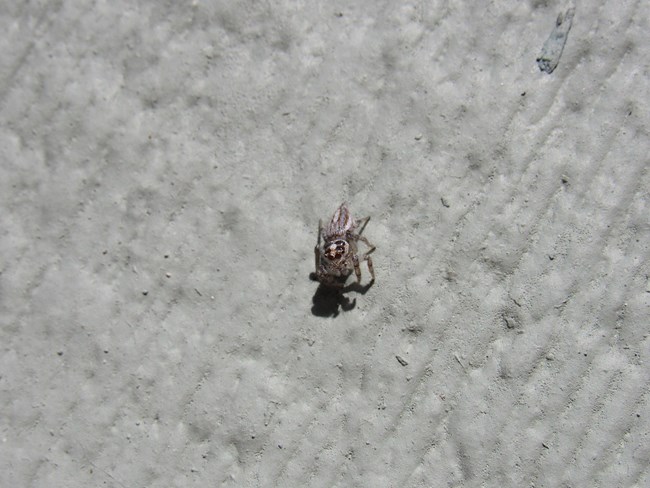
NPS photo/ James C Akers
Jumping Spiders
Phidippus spp.
Terrifying predators of the insect world, jumping spiders are avid hunters. Their large, forward-facing eyes, coupled with their impressive leaping ability make them highly successful at communicable their prey. Jumping spiders accept 2 breathing systems: a book lung and tracheal system. With both of these being well developed, jumping spiders accept bimodal breathing. Their optics are some of the best of all arthropods and are relied upon heavily in hunting, navigation, and even courting for some species.

NPS Photograph/ John Labadie
Recluse Spiders
Loxosceles spp.
While the iconic Chocolate-brown Recluse does have part of its natural range in Texas, information technology does non really extend this far w. The species of recluse spider that we accept here in the park is Loxosceles blanda. Recluse spiders are known for their necrotic venom, though most bites resolve themselves without significant medical intervention. Additionally, these spiders are not ambitious and are reclusive by nature--often times people can exist in close proximity with recluse spiders and never receive a bite.
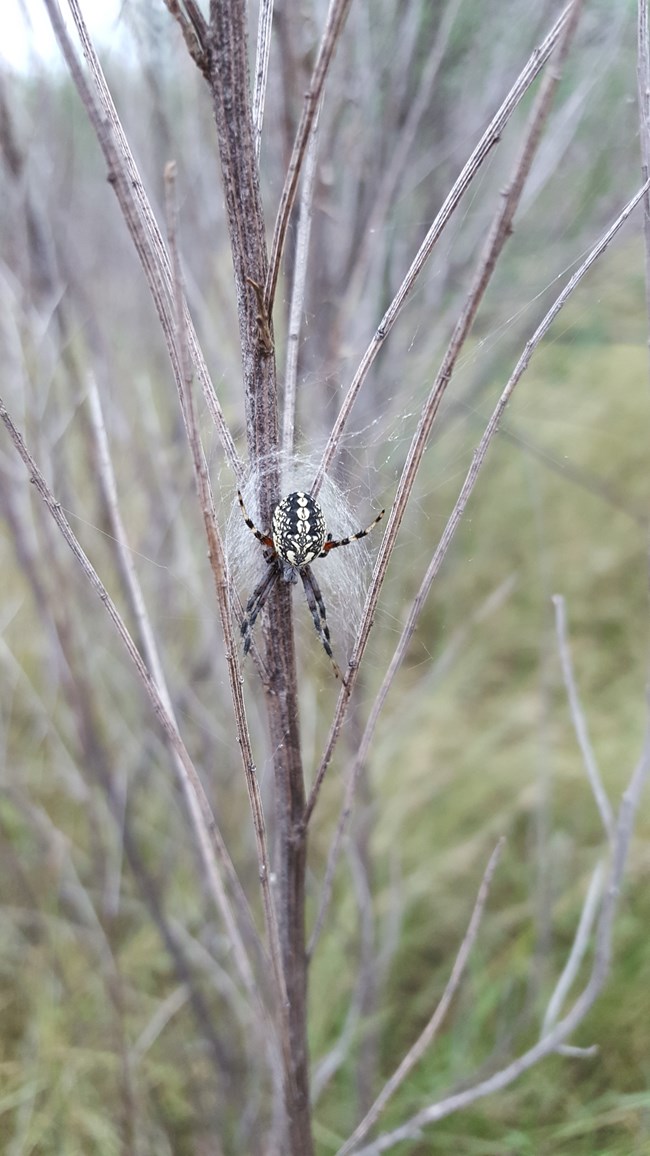
NPS Photo/Alex Klug
Spotted Orb Weavers
Neoscona spp.
Ane of the other spiders found here that makes large, intricate orb webs are the Spotted Orb Weavers in the genus Neoscona. At that place are only 8 species described here in the U.S., each with fairly unique and distinguishing patterns. These spiders are often confused with spiders in the genus Araneus; however, these spiders accept a longitudinal groove in their carapace that distinguishes them. I of the larger and more intimidating Spotted Orb Weavers here is the Western Spotted Orb Weaver, Neoscona oaxacensis. Identifiable from its mottled yellow on black coloration, N. oaxacensis makes large orb webs to capture casualty.
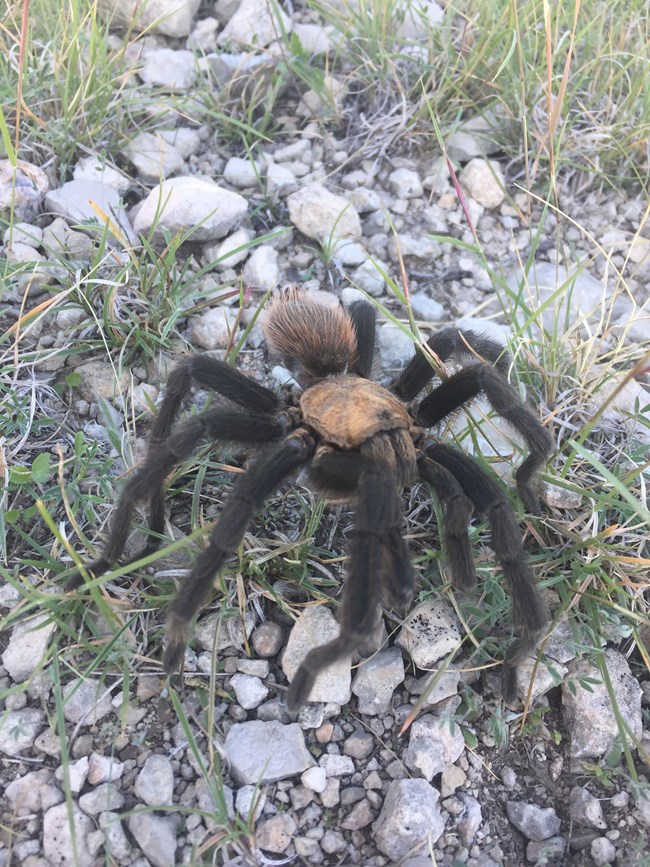
NPS photograph/Amanda Young
Tarantulas
Aphonopelma spp.
Fairly common throughout the Country of Texas, tarantulas are burrowing spiders that are easily identified past their large size. At that place are 14 species of tarantula plant throughout Texas and specific identification is difficult fifty-fifty to those with the proper equipment, literature, and experience. However, some varieties from Northern United mexican states are easier to identify due to their unique color blueprint. Female tarantulas by and large live longer than male tarantulas in Texas and can lay from 100 to thousand eggs in their burrows. Texas species of tarantula by and large remain in burrows and their bite is painful, but non harmful to humans. Despite their venom non being dangerous to humans, the tarantulas here in the Americas accept an additional defense force: urticating hairs. These hairs are kicked off at the spiders' assaulter and crusade irritation when they brand contact with skin.
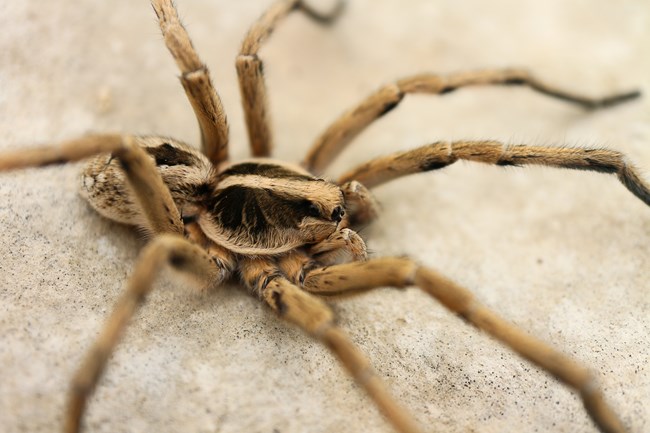
NPS photo/Jack Johnson
Wolf Spiders
Family Lycosidae
Wolf spiders are agile hunters; they rarely create burrows or spin webs. They are largely nocturnal and hunt using their large, forrad facing eyes to attack their prey. Females will lay silk lines along with pheromones to attract mates from far away, and in that location are multiple different courtship routines/methods depending on the species. The female parent wolf spider will carry her babies on her back until they are ready to go off on their ain.
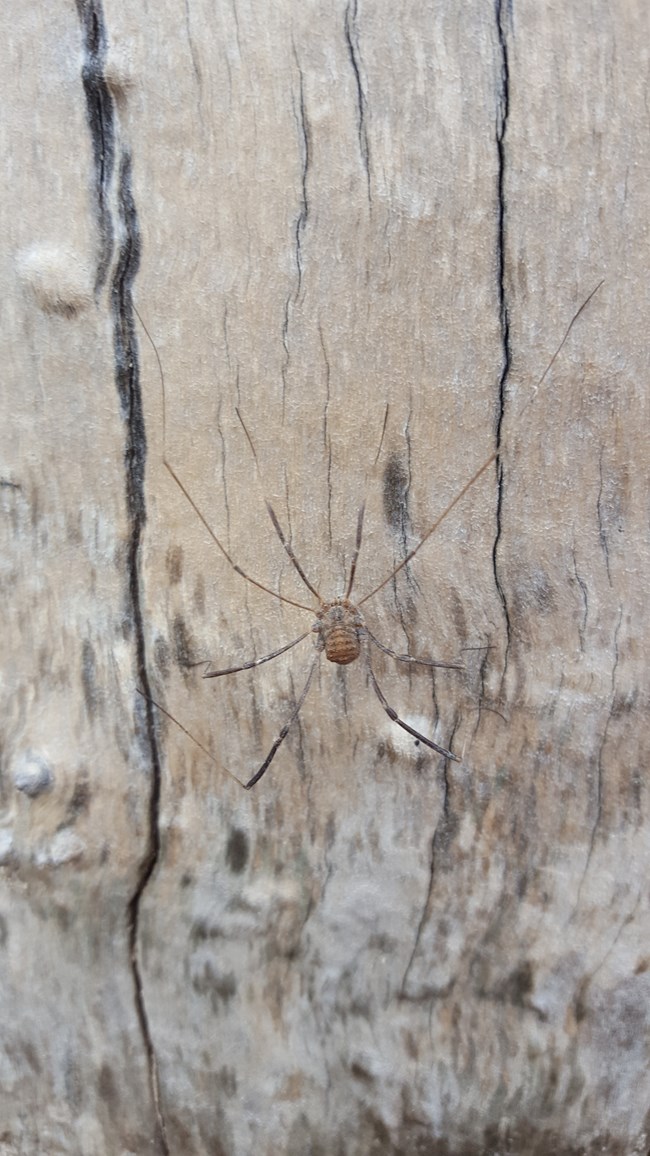
NPS photograph/Alex Klug
Order Opiliones
Harvestmen (likewise sometimes called "daddy longlegs") are distinguishable from spiders by the apparent fusion of the cephalothorax to the abdomen, giving them the appearance of having only one body segment. They also just accept one pair of optics, compared to the iii to iv pairs establish on true spiders. Harvestmen also pose no threat to humans, as they lack venom glands. In addition to lacking venom glands, this society of arachnids also do not produce silk, and therefore practise not make webs. They are opportunistic omnivores, feeding on a wide range of foods from fungi to small insects. Harvestmen are also an ancient order of arachnids, with fossilized specimens from 410 one thousand thousand years ago appearing similar to their mod counterparts, suggesting that they have been on land for even longer.

Camel spiders/Wind scorpions:
Order Solifugae
Direct-Faced Solifugid
Family Eremobatidae
Also known as wind scorpions, straight-faced solifugids are characterized by their distinctive, vertically curved jaws. Unlike other scorpions, they are only able to walk on three pairs of legs, using their slender start pair as sensor organs. Though many people wrongly consider these nocturnal wind scorpions venomous, they lack venom sacks. They are, however, capable of inflicting a painful bite. Like spiders, males are more often than not smaller and have longer legs. Straight-Faced Solifugids only alive upwardly to i yr.
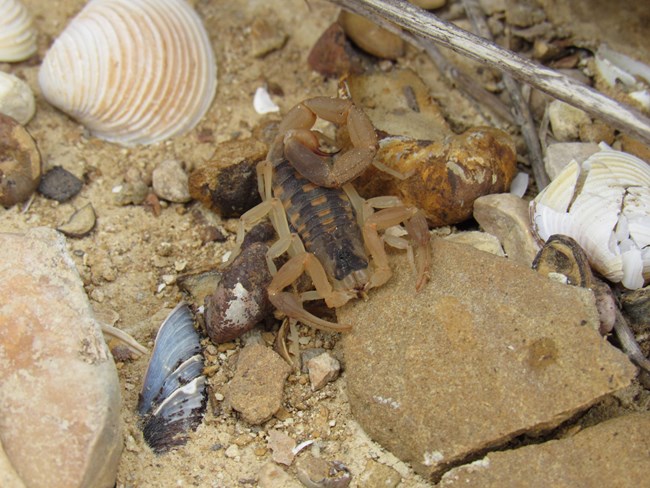
NPS photo/James C Akers
Scorpions:
Order Scorpiones
Striped Bark Scorpion
Centruroides vittatus
The striped bawl scorpion can be recognized by two broad, blackness bands forth the top of its abdomen. Colour can vary from yellow to light tan in adults of the species while younger striped bawl scorpions are darker in color. Striped bark scorpions mate in fall, winter, and early on jump, and take a lifespan of upward to four years. The sting of this scorpion causes swelling and localized pain.

Whipscorpions:
Society Uropygi
Vinegaroon
Mastigoproctus giganteus
The 3-inch trunk of the vinegaroon makes information technology the largest known whip scorpion. Different other nocturnal creatures, the vinegaroon has poor eyesight and relies on its keen senses to feel vibrations and detect its prey. Though it prefers a desert habitat it is as well common in grasslands. The vinegaroon has no stinger, only its whip-like tail sprays an acidic solvent that can eat through the exoskeleton of other insects and smells remarkably like vinegar
Source: https://www.nps.gov/amis/learn/nature/arachnids.htm
0 Response to "If Olios Giganteus Has Babies Indoors Will They Go Outside"
Postar um comentário